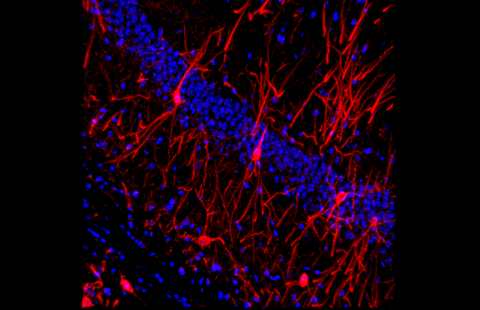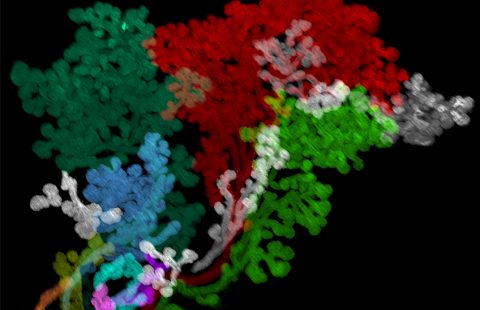 © AdobeStock
© AdobeStock
Why does some music make us want to dance more than others? This is the question that a research team from Inserm and Aix-Marseille Université tried to answer by studying the desire to dance (also called the ‘groove’) and the brain activity of 30 participants who were asked to listen to music. Their findings show that the groove sensation is highest for a moderately complex rhythm and that the desire to move is reflected in the brain by an anticipation of the music’s rhythm. This research, to be published in Science Advances also designates the left sensorimotor cortex[1] as being the centre of coordination between the auditory and motor systems.
Dancing means action. But to dance to the sound of a melody, you still have to coordinate your actions with the rhythm of the music. Previous studies have already shown that the motor system (consisting of the motor cortex[2] and all the brain structures and nerve pathways which, under its control, participate in the execution of movement) plays a crucial role in the brain’s processing of musical rhythms.
‘Groove’ is the spontaneous desire to dance to music. But while some music has us immediately heading for the dance floor, others leaves us indifferent. So what is it that makes some music more ‘groovy’ than others?
A research team led by Benjamin Morillon, Inserm researcher at the Institute of Systems Neurosciences (Inserm/Aix-Marseille Université), looked at the neural dynamics (i.e. the interactions between neurons resulting from the electrical activity of the brain) of 30 participants when they listened to pieces of music whose rhythms were of greater or lesser complexity. This was to determine the brain mechanisms involved in the emergence of the groove sensation.
To do this, the team started by creating 12 short melodies comprised of a rhythm of 120 beats per minute – or 2 Hz, the average rhythm generally found in music. Each melody was then modified in order to obtain three variants with an increasing degree of syncopation[3] (low, medium, high) – i.e. with an increasingly complex rhythm, but without changing either the speed of the rhythm or the other musical characteristics of the melody.
The researchers then asked the participants to listen to these melodies while recording their brain activity in real time using a magnetoencephalography (MEG) device. At the end of each melody, the participants were asked to score the level of groove felt.
They also created a so-called ‘neurodynamic’ mathematical model of the neural network that describes in a simple way the brain calculations required for the emergence of the groove.
The experience of the groove as reported by the participants – and reproduced by the neurodynamic model – appeared to be correlated with the rate of syncopation. As observed in previous studies, the desire to move to music was highest for a rhythm with an intermediate level of syncopation, i.e. not too simple or too complex.
‘These findings show that the motor engagement linked to the groove is materialised by a temporal anticipation of the tempo. At brain level, this is based on a dynamic balance between the temporal predictability of the rhythm (the less complex the rhythm, the better it is) and the listener’s temporal prediction errors (the more complex the rhythm, the more errors they make),’ explains Arnaud Zalta, first author of the study and post-doctoral fellow at ENS-PSL.
Analysis of the participants’ brain activity then enabled the researchers to highlight the role of the left sensorimotor cortex as coordinator of the neural dynamics involved in both auditory temporal prediction and the planning and execution of movement.
‘The brain region which is the site of the left sensorimotor cortex is currently considered to be the potential cornerstone of sensorimotor integration, essential for the perception of both music and speech. The fact that it appears in our study as necessary for ‘cooperation’ between the auditory and motor systems reinforces this hypothesis, especially as we are using natural stimuli here,’ concludes Morillon.
[1]In the brain, the sensorimotor cortex consists of the motor cortex and the sensory cortex (postcentral gyrus, at the front of the parietal lobe), separated by the central fissure. Involved in the coordination of movements, it receives sensory information from the different parts of the body and integrates it to adjust and refine the movements generated by the motor cortex.
[2]The motor cortex consists of the regions of the cerebral cortex that participate in the planning, control and execution of voluntary muscle movements. It is located in the posterior part of the brain’s frontal lobe, in the precentral gyrus.
[3]In rhythmic solfège, if we consider the 4/4 measure, beats 1 and 3 are ‘strong’ and beats 2 and 4 are ‘weak’. Syncopation is a rhythm in which a note (or a chord) is started on a weak beat and prolonged over the next strong beat. For the listener, this creates a shift in the expected accent, perceived as a kind of musical ‘hiccup’ that disrupts the regularity of the rhythm. These musical motifs are particularly present in funk or jazz.
These contents could be interesting :
 © AdobeStock
© AdobeStock
